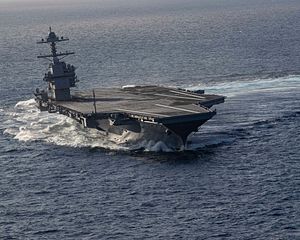The USS Gerald R. Ford (CVN-78), the most expensive warship in U.S. Navy history, may not be ready to put to sea until 2024, according to a recent congressional testimony as the service has still not announced an estimated deployment date of the flattop.
USNI News reports that the new deployment date came up during a House Armed Services readiness subcommittee hearing last month in an exchange between Naval Sea Systems Command head, Vice Admiral Tom Moore, and Representative Elaine Luria of Virginia.
“The original deployment was 2018 and best estimates we’re looking at 2024?” Luria was quoted as asking Moore during the hearing. “I think we’ll beat that,” Moore said in response. “We’re going to pull back as far to the left as we can, but I think we’re going to beat that.”
In response, Secretary of the Navy, Richard V. Spencer said on October 23 during a panel discussion in Washington DC that the “ship will be ready to serve and do what it’s going to do in the time that the CNO [Chief of Naval Operations] thinks is appropriate, and it’s going to be sooner than 2024.”
He added that the 2024 date refers to when the Ford’s air wing will be stationed aboard and certified for operations.
The Ford incorporates several untried new technologies including advanced weapons elevators, main turbine generators, a new dual-band radar system, a new advanced arresting gear on the flight deck, as well as the new electromagnetic aircraft launch system.
These new technologies were one of the reasons for the carrier’s developmental delays. Another reason has been the decision to have the USS Gerald R. Ford undergo shock testing before its first deployment. The flattop was originally slated to deploy in 2018. A new tentative date was set for 2022.
The USS Gerald R. Ford completed its year-long post-shakedown availability (PSA) period at Newport News Shipbuilding in Newport News, Virginia on October 30, according to a U.S. Navy statement. PSA addressed various technical deficiencies and resolved issues that arose during initial at-sea periods of the carrier by making needed changes and upgrades.
“The CVN 78 PSA began on July 15, 2018, and included work on Advanced Weapons Elevators (AWEs), repairs to the ship’s main reduction gear, improvements to the throttle control system, upgrades to the Advanced Arresting Gear, and numerous other maintenance tasks,” the Navy said in an October 30 statement.
Nine of the eleven electromagnetically powered AWE’s used for carrying munitions from the carrier’s magazine to the hangar are not working.
“CVN 78 began construction with immature technologies and an incomplete design, leading to cost and schedule growth,” the U.S. Government Accountability Office noted in an April 2018 report. “The ship delivered 20 months later than the Navy planned, with construction-related work still remaining and over 40 serious deficiencies that could impact ship operation or safety.” Total cost for the first-of-class is estimated at almost $13 billion.
According to the October 30 U.S. Navy statement:
The Gerald R. Ford class incorporates 23 new technologies, comprising dramatic advances in propulsion, power generation, ordnance handling and aircraft launch systems. These innovations will support a 30 percent higher sortie generation rate, executed with a 20 percent reduction in crew, at a significant cost savings, when compared to Nimitz-class ships. The Gerald R. Ford-class carrier offers a 17 percent reduction — approximately $4 billion per ship — in life cycle operations and support costs compared to the earlier Nimitz class.
As a recent analysis published by Forbes points out, this is less of an efficiency boost than initially advertised by the U.S. Navy.

































